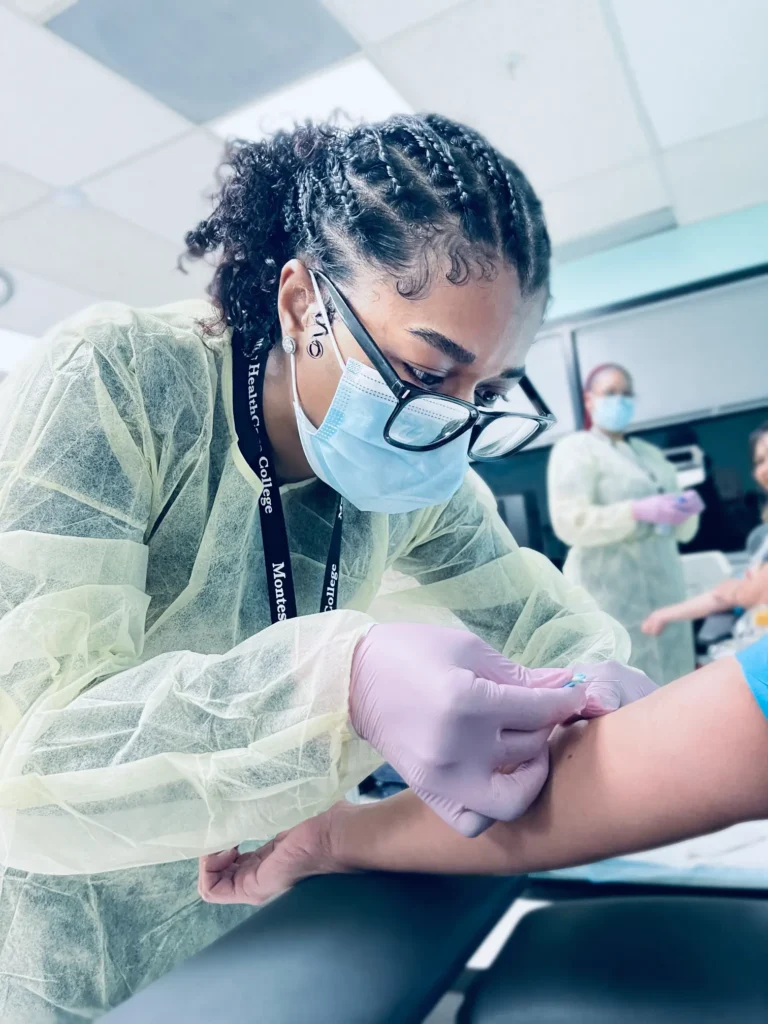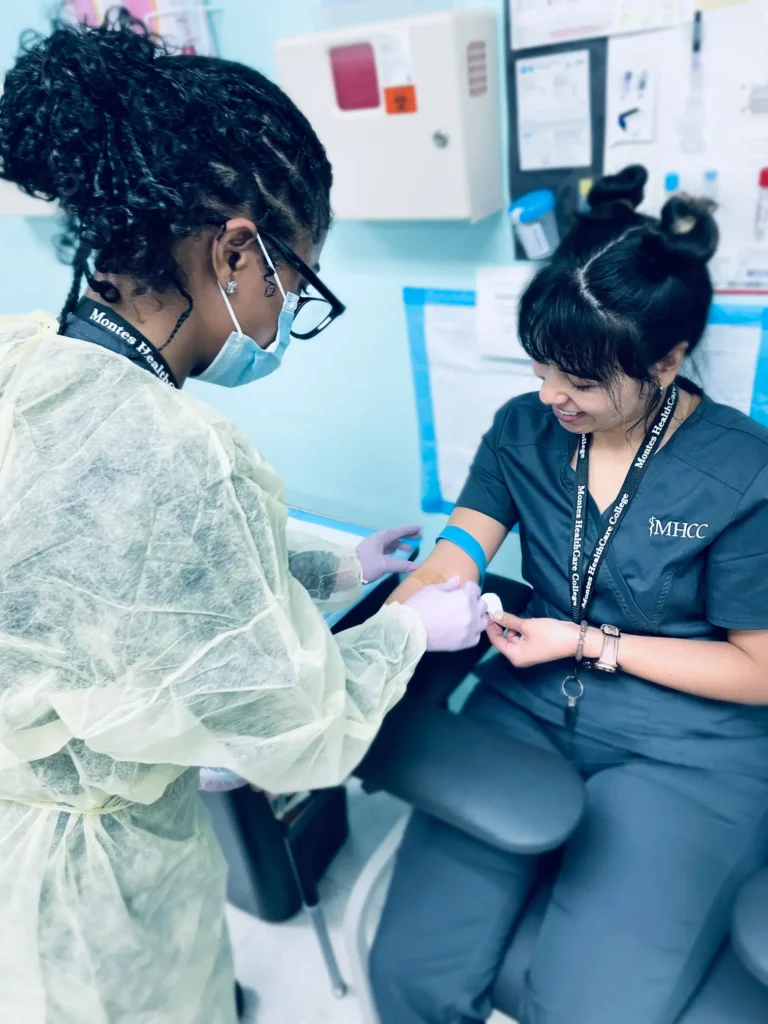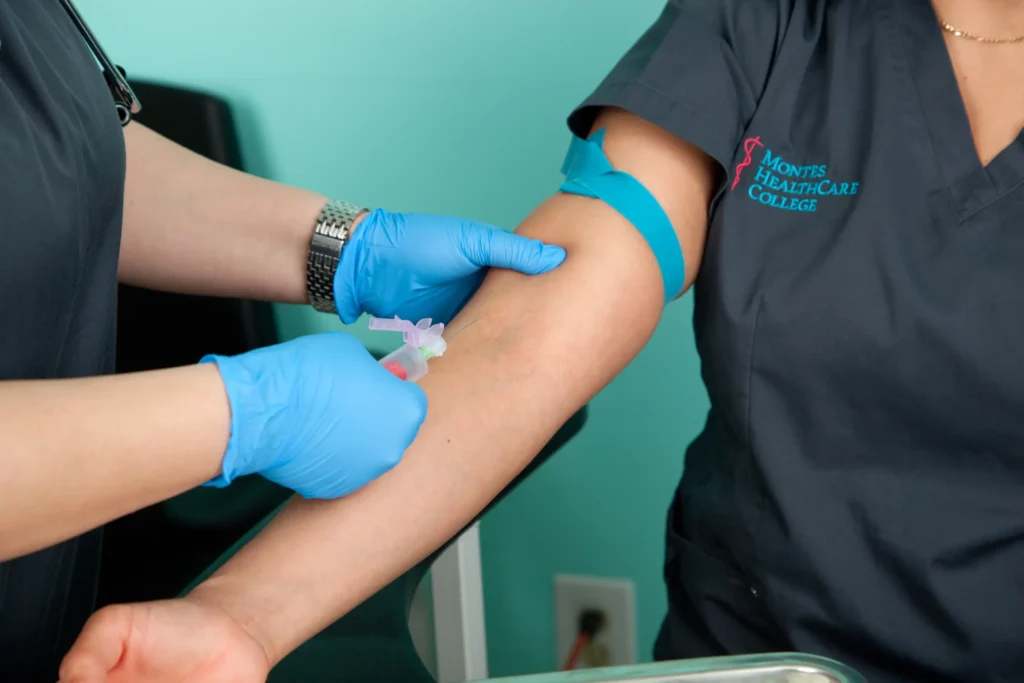One of the biggest frustrations phlebotomists face is running into a “difficult stick”, a situation when it’s difficult to draw blood from the vein. It happens more often than you might think, and it’s not limited to one group. You’ll see it in older adults, younger patients, and everyone in between. That’s why we’ve put together some go-to tips on what to do when it’s difficult to draw blood.
Why is it Difficult to Draw Blood From Veins?
There could be many reasons why it’s difficult to draw blood from some patients. One of the most common is that some people just naturally have veins that are hard to access.
This can be due to:
- Small veins (These veins are thin and narrow, making them tough to puncture without missing.)
- Deep veins (These sit further under the skin, so they’re harder to feel and see.)
- Rolling veins (These move or shift when you try to insert the needle, which can throw off your aim.)
Difficult blood draws are part of the daily duties of a phlebotomist. See how a day in life of a phlebotomist looks like in this guide.
Same as they are part of daily duties, so are they part of challenges that phlebotomists encounter.
Tips for Drawing Blood From Difficult Veins
For small veins, try using a smaller needle and warming the area first. This can help increase blood flow and make the vein easier to access.
For deep veins, make sure to anchor well, use a longer needle, and insert it at a lower angle to reach the vein more effectively.
For rolling veins, your best bet is to anchor the vein firmly to keep it from shifting, then go in at a shallow angle for better control.
If you’re planning to become a phlebotomist, our program is built to prepare you for exactly these kinds of challenges, so when the “difficult sticks” show up, you’ll know how to handle them with skill and confidence.
Other Reasons for a Difficult Blood Draw
Sometimes, it’s not just the veins themselves that make a draw difficult. Other factors can get in the way too. Here are a few common ones and how to work around them:
Low Body Temperature
Cold environments or poor circulation can cause vasoconstriction, making veins shrink and harder to find.
Solution
A heat pack can help you in those situations. By increasing the temperature of that area, you could make drawing blood from difficult veins much easier.
Low Pain Tolerance
Some patients are extremely sensitive to pain or are scared of needles. They may flinch or pull away, which can disrupt the draw. They may flinch or pull away, which can disrupt the draw. In extreme cases, anxiety can even cause patients to faint during the blood draw
Solution
Take a calm, reassuring approach. Go slow, be gentle, and let them know they’re in capable hands.
Dehydration
If your patient hasn’t been drinking enough water, especially the day before, their veins can be less visible and harder to puncture.
Solution
A quick glass of water likely won’t fix the issue on the spot, since hydration takes time to reach the bloodstream. But if it’s a recurring problem, encourage patients to drink plenty of fluids the day before their appointment.
Age
Older adults often have fragile, less elastic veins that are more prone to collapse.
Solution
In these situations, use a smaller gauge needle, take your time locating the best vein, and be extra gentle with insertion.
Scar Tissue
Repeated draws from the same site can cause scar tissue to build up, making veins less elastic and more difficult to puncture.
Solution
You should rotate draw sites whenever possible. So try a different vein or switch arms. A butterfly needle or smaller gauge may also help reduce additional trauma.

How to Draw Blood From Difficult Veins?
Sooner or later, you’ll have a patient with hard-to-find veins, it’s part of the job. When it happens, stay calm and apply the specific tips we outlined above for the situation you’re dealing with.
On top of that, here are a few extra tips to make the whole process smoother:
- Stay confident and composed. Patients can feel your energy. If you come across as calm and steady, even nervous patients can start to relax.
- Show empathy. A lot of people get anxious around needles. Let them know it’s completely normal and reassure them that you’ve helped plenty of others who feel the same way but you still got the job done smoothly.
- Take a breath before you poke. Whether it’s your first draw of the day or your fiftieth, give yourself a second to steady your hands and focus. It makes a difference.
- Don’t take reactions personally. Some patients might seem irritated or scared. Most of the time, it’s not about you. It’s about past experiences. Stay professional and grounded.
- Talk them through it. Some patients feel more in control when they know what’s going on. Walk them through each step in a calm, simple way. This can help build trust and ease tension.

Useful Things for Phlebotomists to Know
Whether you’re just starting out or brushing up on your skills, these tips can help you feel more prepared and more confident.
How to Practice Blood Draws at Home?
You can’t practice on real people at home (and definitely shouldn’t without supervision), but you can use a phlebotomy practice kit. These often come with fake arms, veins, and simulated blood. It’s a good way to build muscle memory and get more comfortable with the technique.
How to Apply a Tourniquet for a Blood Draw?
Place it about 3-4 inches above the intended puncture site. It should be snug, tight enough to restrict venous blood flow, but not so tight that it stops arterial circulation or causes discomfort. Don’t leave it on for more than a minute or two.
How to Insert a Needle for a Blood Draw?
Hold the needle bevel-up, aim at about a 15–30 degree angle, and insert in one smooth motion. Once you see a flash of blood in the hub, stabilize the needle and proceed with the collection.
How to Make Blood Drawing Easier?
Get the basics right. Good lighting, a calm environment, and patient communication. Warming the site, choosing the right needle, and anchoring the vein properly all help too. Confidence and focus go a long way.
How to Make Veins More Visible for a Blood Draw?
Warm the area, apply a tourniquet, or gently tap the skin. Hydration also helps. Encourage patients to drink water the day before and the day of the draw.
How Common is Nerve Damage From a Blood Draw?
It’s rare but possible. If a patient feels a sharp, electric, or burning pain, stop immediately. Avoid probing or fishing with the needle, which raises the risk.
Why Do You Remove the Tourniquet During a Blood Draw?
The tourniquet should come off once blood flow is established. Leaving it on too long can lead to hemoconcentration and affect the quality of the sample. It can also cause discomfort or bruising.
Why Does Blood Stop Flowing During a Blood Draw?
A few reasons: vein collapse, poor needle placement, or the bevel pressing against the vein wall. Sometimes the vacuum in the tube isn’t strong enough, or the vein just rolls. Repositioning slightly or switching tubes may help.
Why Do Veins Blow During a Blood Draw?
A blown vein happens when the vein is punctured through or the wall is damaged. This can be caused by using too large a needle, poor technique, or fragile veins. You’ll usually see swelling and bruising right away.
Does a Collapsed Vein After a Blood Draw Happen Often?
Not often, but it’s more likely in patients with small, weak, or overused veins. It’s usually temporary, though in some cases, the vein may not bounce back fully.
Why Does a Busted Vein Happen After a Blood Draw?
It usually means the vein was punctured or injured during the draw. This can lead to bruising, swelling, or a hematoma. It’s more likely if the patient moves suddenly or if the needle angle is off.
Why Does the Vein Bulge After a Blood Draw?
A little bulging can be normal, especially if the vein is still dilated from the tourniquet. If it’s accompanied by pain or swelling, it might be a hematoma or irritation. Keep an eye on it.
Final Thoughts
Difficult blood draws are part of the phlebotomy world. Whether its rolling veins, needle anxiety, or tricky anatomy, every phlebotomist faces these moments. The key is knowing what to do and staying calm while you do it.
If you’re serious about mastering these skills and building the confidence to handle any patient, our Phlebotomy Technician Program is built for you. We don’t just teach you the steps. We prepare you for real-world challenges so you can walk into every draw ready, focused, and in control.

